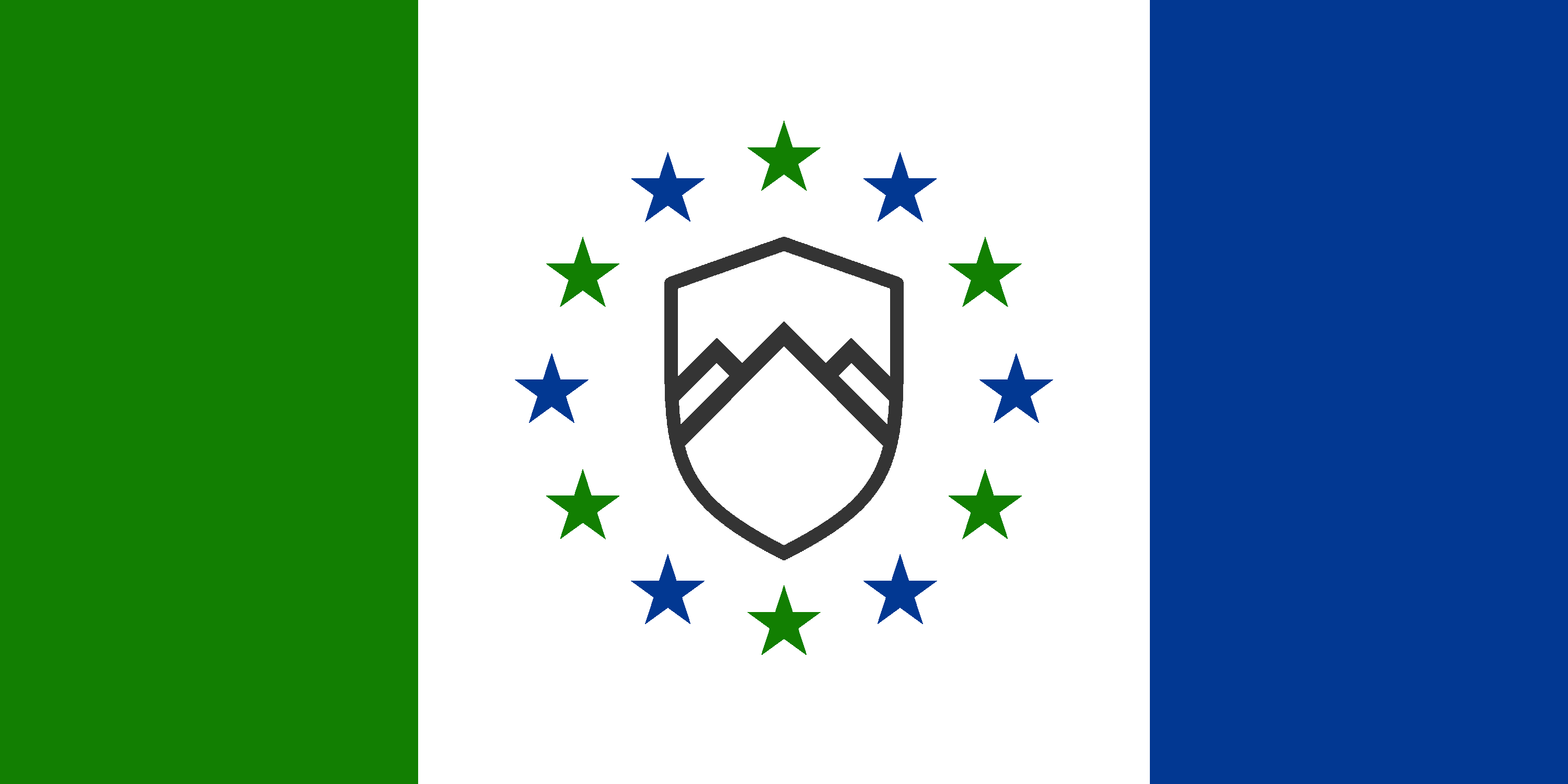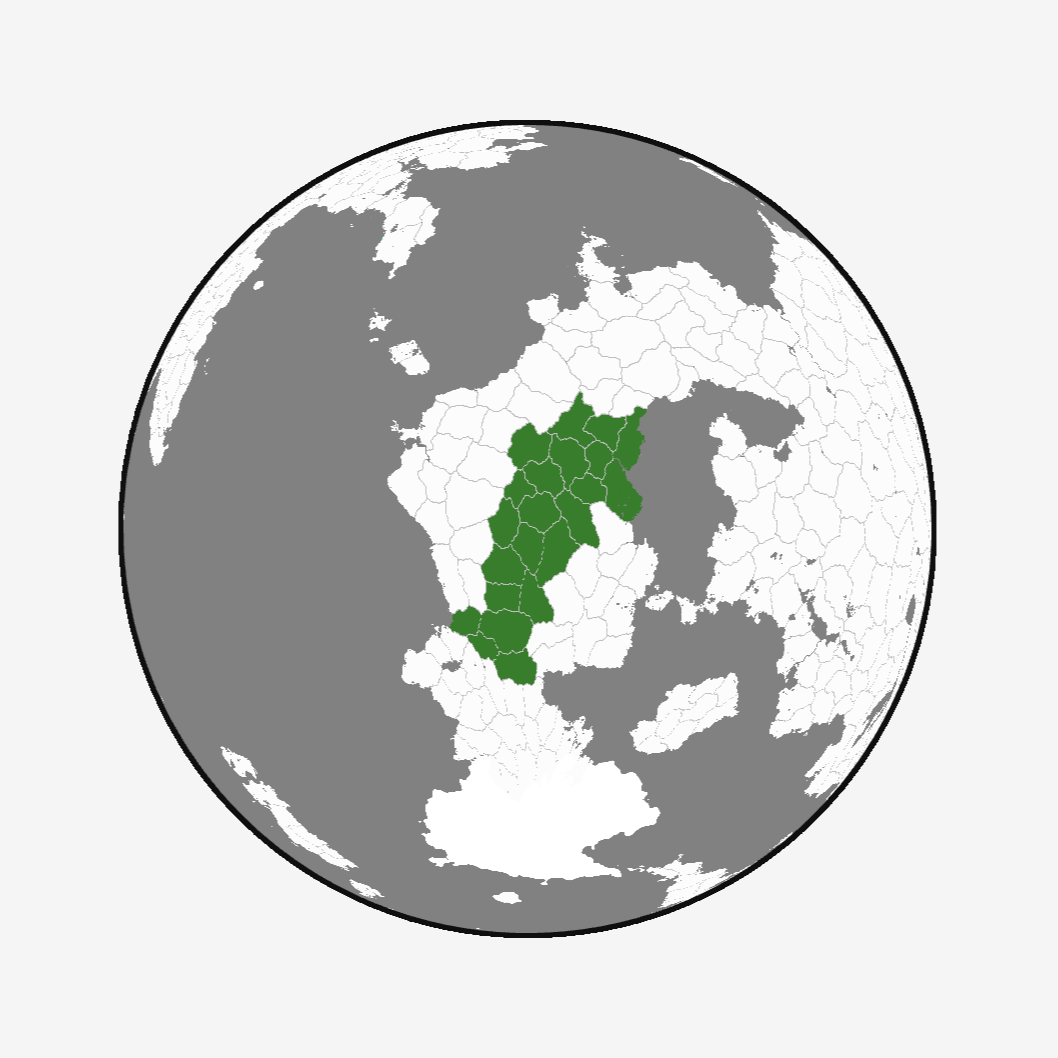New Kalban Republic: Difference between revisions
Slippulter (talk | contribs) No edit summary |
mNo edit summary |
||
| (9 intermediate revisions by 2 users not shown) | |||
| Line 1: | Line 1: | ||
{{Nation |
{{Nation |
||
| − | |nation = New Kalban Republic |
+ | | nation = New Kalban Republic |
| + | | localized_name = Nova Kalbanska Republika |
||
| − | |flag = NKR Flag.png |
+ | | flag = NKR Flag.png |
| − | |flagdesc = |
+ | | flagdesc = Peacetime flag of the New Kalban Republic |
| − | |motto = "U Jedinstvu, Spasenje" </br> ( |
+ | | motto = "U Jedinstvu, Spasenje" </br> (Through Unity, Salvation) |
| − | |full_name = New Kalban Republic |
+ | | full_name = New Kalban Republic |
| − | |anthem = [https://www.youtube.com/watch?v=i4YfIb9HYwY Himna Kalbanskoj Republici] |
+ | | anthem = [https://www.youtube.com/watch?v=i4YfIb9HYwY Himna Kalbanskoj Republici] |
| − | |map = NKR Map 2.png |
+ | | map = NKR Map 2.png |
| − | |mapdesc = Map of the Kalbans, with the NKR marked in green |
+ | | mapdesc = Map of the Kalbans, with the NKR marked in green |
| − | |denonym = Kalbanian |
||
| − | | |
+ | | denonym = Kalbanian |
| + | | languages = Kalbanian </br> Laythi |
||
| − | |capital = Dolinia |
+ | | capital = Dolinia |
| − | |currency = Kalban Official Kinta </br> Kalban Dinar |
+ | | currency = Kalban Official Kinta </br> Kalban Dinar |
| − | |government = Parliamentary Repbulic |
+ | | government = Parliamentary Repbulic |
| − | |foundation = 2138 |
+ | | foundation = 2138 |
| ⚫ | |||
| + | | leader_title = Premijer |
||
| ⚫ | |||
| ⚫ | |||
| ⚫ | |||
| ⚫ | |||
| ⚫ | |||
| ⚫ | |||
| ⚫ | |||
| ⚫ | |||
| ⚫ | |||
| ⚫ | |||
| ⚫ | |||
}} |
}} |
||
| − | The New Kalban Republic (Kalban: Nova Kalbanska Republika), also known as Kalbanija or NKR, is a country in Central Veiid, and the successor of the Socialist Federative Republic of Kalbanija. The NKR borders [[Arvene]], [[Fortis]], and [[Belka]], and has maritime acess to the minor and major Baskay Bay, as well as the Tau Sea. The total land area of Kalbanija is 62,286km² |
+ | The '''New Kalban Republic''' (Kalban: ''Nova Kalbanska Republika''), also known as '''Kalbanija ''' or the '''NKR''', is a country in Central [[Veiid]], and the successor of the Socialist Federative Republic of Kalbanija. The NKR borders [[Arvene]], [[Fortis]], and [[Belka]], and has maritime acess to the minor and major Baskay Bay, as well as the Tau Sea. The total land area of Kalbanija is 62,286km². The nation has a population of 4,155,020 according to the 2159 Census. |
Kalbanija is a multi-party parliamentary republic. The capital and largest city is Dolinia, located in a valley in the nation's north, with a metropolitan area population of aproximately 900,000 kerbals. Other major cities include Nridia, Pecovia, Karjina, Sug and Bof. |
Kalbanija is a multi-party parliamentary republic. The capital and largest city is Dolinia, located in a valley in the nation's north, with a metropolitan area population of aproximately 900,000 kerbals. Other major cities include Nridia, Pecovia, Karjina, Sug and Bof. |
||
| Line 31: | Line 33: | ||
==Geography== |
==Geography== |
||
Kalbanija is a mountainous country, with two notable mountain chains covering it's territory. The Karjina Mountains are located in the nation's north, and have multiple peaks reaching 4500m above sea level. The central are of Kalbanija is a mostly flat plain, while the south is covered in the (TEMP) Mountains. Largest river in the country is the Nridia river, located in the north-east of Kalbanija. It's shores and the plains surrounding it are mostly flat, and provide fertile farming grounds. |
Kalbanija is a mountainous country, with two notable mountain chains covering it's territory. The Karjina Mountains are located in the nation's north, and have multiple peaks reaching 4500m above sea level. The central are of Kalbanija is a mostly flat plain, while the south is covered in the (TEMP) Mountains. Largest river in the country is the Nridia river, located in the north-east of Kalbanija. It's shores and the plains surrounding it are mostly flat, and provide fertile farming grounds. |
||
| + | The NKR also includes East Hook Island, at the entrance into Minor Baskay Bay. |
||
[[File:Template_Relief.png|thumb]] |
[[File:Template_Relief.png|thumb]] |
||
===Climate === |
===Climate === |
||
| + | The NKR has a mostly cold climate, with slightly warmer temperatures in the western plains. |
||
| − | <nowiki>###</nowiki> |
||
===Biodiversity === |
===Biodiversity === |
||
<nowiki>###</nowiki> |
<nowiki>###</nowiki> |
||
| Line 59: | Line 62: | ||
<nowiki>###</nowiki> |
<nowiki>###</nowiki> |
||
===Age=== |
===Age=== |
||
| + | Kalbanija has an overall young population, as a consequence of recent growth following the rebuilding of Kalbanija, and the low population in the region prior to it. The country is currently enjoying a large working population, with comparatively low number of elderly (and economically non-productive) kerbals. Population growth is slowing, and presents a threat of a demographic crisis in the early 2200's. |
||
| − | <nowiki>###</nowiki> |
||
<br/> |
<br/> |
||
==Military == |
==Military == |
||
| Line 76: | Line 79: | ||
<br/> |
<br/> |
||
==Economy== |
==Economy== |
||
| + | The NKR has two official currencies, the Kalban Dinar (KAD) and the Kalban Official Kinta (KAK). The Kinta is the currency used for official purchases, international trade, and as a reserve currency. The Dinar meanwhile is the common currency, used by the regular Kalban citizens, and accepted by Kalban shops and stores. |
||
===Taxation=== |
===Taxation=== |
||
<nowiki>###</nowiki> |
<nowiki>###</nowiki> |
||
| Line 99: | Line 103: | ||
<br/> |
<br/> |
||
==About The Flag== |
==About The Flag== |
||
| + | The NKR has two official National flags - The Green-White-Blue Flag of the Republic, which is the official National flag during peacetime, and the Red-White-Black War flag, which is the flag flown in wartime. It is also used as the flag of the Armed Forces, even during peacetime. |
||
| − | Coming Soon |
||
| + | |||
| + | === Flag of the Republic === |
||
| + | Flag of the republic is the official name of the peacetime flag. It is a Green-White-Blue Vertical Tricolor, with a silver coat of arms in the center, surrounded by 12 Stars. The flags represent the geography of Kalbanija; the green represents the plains of Nridia, the Blue stands for the waters present in the nation, especially Minor Baskay Bay (And it is located on the right side of the flag, as the bay is to the East of the nation), while the white represents the snowy heights in the South. The Coat of arms is a stylized depiction of Mountains, which can be found at the southern and northern ends of the nation. The coat of arms is silver, to represent the grayish-silver color the mountains are known for. 12 Stars surround the flag, as a reminder of the 12 Civil War generals who, from different sides, agreed to stop the war, and work together to rebuild the nation and make a New Kalbanija. |
||
| + | |||
| + | === War Flag of the Kalban Republic === |
||
| + | War Flag of the Kalban Republic is the official name of the wartime flag and army standard, but it is also known as the Banner of the Fatherland. It represents the Kalban nation during wartime, and is also used as the Military Standard of the Kalban Armed Forces (Excluding the People's Militia forces), The flag looks similar to the Flag of the Republic, also being a Vertical tricolor, and having the same 12 stars in the center. However, the colors are changed to a Red-White-Silver combination, and the coat of arms is replaced by a map showing what the NKR Considers Kalban Lands, showing what the Kalban forces are fighting for. The different colors also carry different meanings, with the red representing the blood spilled to defend and liberate Kalbanija, and Kalban lands, while the silver symbolizes the industry and metal needed for the fight. As such the flag represents and recognizes both the soldiers spilling their blood on the frontlines, and the people working in industry. The White color on the flag represents the wish for peace, and end to the horrors of war, which most of the Kalban population has lived trough. |
||
| + | |||
[[File:NKR Flag.png|thumb|400px|Peacetime flag of the New Kalban Republic]] |
[[File:NKR Flag.png|thumb|400px|Peacetime flag of the New Kalban Republic]] |
||
[[File:NKR War Flag.png|thumb|400px|Banner of the Kalban Armed Forces, and wartime national flag]] |
[[File:NKR War Flag.png|thumb|400px|Banner of the Kalban Armed Forces, and wartime national flag]] |
||
Latest revision as of 00:41, 11 March 2025
|
New Kalban Republic
Nova Kalbanska Republika
|
|||||
|---|---|---|---|---|---|
 |
|||||
| Peacetime flag of the New Kalban Republic | |||||
| Motto | "U Jedinstvu, Spasenje" (Through Unity, Salvation) |
||||
| Common Name | New Kalban Republic | ||||
| Anthem | Himna Kalbanskoj Republici | ||||
 |
|||||
| Map of the Kalbans, with the NKR marked in green | |||||
| Demonym | Kalbanian | ||||
| Official languages | Kalbanian Laythi |
||||
| Currency | Kalban Official Kinta Kalban Dinar |
||||
| Politics | |||||
| Capital | Dolinia | ||||
| Government | Parliamentary Repbulic | ||||
| Foundation | 2138 | ||||
| Premijer | Andrej Jovanovic-Kerman | ||||
| Preceded by | SFRK | ||||
| Followed by | Novenad | ||||
| Demography | |||||
| Ethnicities | Kerbian Troak Karkow Laythi |
||||
| Population | 4,155,020 | ||||
| Area | 62,286 km² | ||||
The New Kalban Republic (Kalban: Nova Kalbanska Republika), also known as Kalbanija or the NKR, is a country in Central Veiid, and the successor of the Socialist Federative Republic of Kalbanija. The NKR borders Arvene, Fortis, and Belka, and has maritime acess to the minor and major Baskay Bay, as well as the Tau Sea. The total land area of Kalbanija is 62,286km². The nation has a population of 4,155,020 according to the 2159 Census.
Kalbanija is a multi-party parliamentary republic. The capital and largest city is Dolinia, located in a valley in the nation's north, with a metropolitan area population of aproximately 900,000 kerbals. Other major cities include Nridia, Pecovia, Karjina, Sug and Bof.
Etymology
The name Kalbanija originates at least from the 1400s, as a name the local Kerbian, Troak and Behian people gave to the regions surrounding the Minor Baskay Bay, and has been used as a name for states occupying the are since at least 2045.
New Kalbania specifically comes from the post civil war wish of rebuilding the nation into "a new Kalbanija", a functional, united state, like the KSKM and SFRK who came before it.
Geography
Kalbanija is a mountainous country, with two notable mountain chains covering it's territory. The Karjina Mountains are located in the nation's north, and have multiple peaks reaching 4500m above sea level. The central are of Kalbanija is a mostly flat plain, while the south is covered in the (TEMP) Mountains. Largest river in the country is the Nridia river, located in the north-east of Kalbanija. It's shores and the plains surrounding it are mostly flat, and provide fertile farming grounds. The NKR also includes East Hook Island, at the entrance into Minor Baskay Bay.
Climate
The NKR has a mostly cold climate, with slightly warmer temperatures in the western plains.
Biodiversity
###
Urban Areas
###
Politics
Government
Kalbanija is a parliamentary republic with 2 houses of parliament. The lower house is directly elected in general elections, while the upper house is 1/3 elected in general elections, 1/3 elected from the military, 1/3 elected from public owned companies and industry. There also exists the Council of Nationalities with limited veto power, to block laws seen as discriminatory against national and ethnic groups in the country. Most notably, the council blocked certain resolutions of parliament during the Kalban-Fortis Troak Crisis, on the basis of the resolutions discriminating against the Troak national minority.
The major political parties in the Kalban parliament are the Politicko Krilo Armije - PKA (Political wing of the Army), Kalbaska Socijalisticko-Komunisticka Partija - KSKP (Kalbanian Socialist-Communist Party), Liberalno-Pacifisticka Stranka "Mir" -LPS (Liberal Pacifict Party "Peace") and Kalbanska Nacionalna Stranka - KNS (Kalban National Party). They act as complex coalition organisations under which exist a plethora of smaller parties that compete in local elections, and sometimes ethnicity specific parties that fill the seats of the Council of Nationalities.
Subdivisions
The country's first level divisions are provinces, usually formed around a significant city or group of cities.
Foreign Relations
New Kaban Republic is a regional power with some global influence. It was a founding member of the Second Non-Aligned movement, and orchestrated the events leading to the demise of the IU.
Demographics
Kerbians make up the majority of the nation's population at about 60%, with Troaks, Karkowites and Laythians making up the remaining 40%.
Languages and Culture
###
Education
###
Religion
###
Age
Kalbanija has an overall young population, as a consequence of recent growth following the rebuilding of Kalbanija, and the low population in the region prior to it. The country is currently enjoying a large working population, with comparatively low number of elderly (and economically non-productive) kerbals. Population growth is slowing, and presents a threat of a demographic crisis in the early 2200's.
Military
Kalban Airforce and Air Defense
###
Kalbanian National Army
###
Kalban People's Militia
The Kalban People's Militia is the only army branch authorized to operate on Kalban Soil, and consists of Active and Reserve Elements. The Active elements are heavy policing units, who serve as special forces with the Kalban Police, dealing with high-intensity internal actions, such as separatist attacks, terrorist actions and similar. They operate light armored vehicles, trainer and COIN aircraft, and helicopters.
The reserve element is composed of military reserve units, who's peacetime purpose is simply maintenance of equipment and reservist training. Their role is to mobilize the Kalban population and to activate trained reservists in case of an attack on Kalbanija. Here they would work with other branches of the Kalban Armed Forces in defense of the nation, and liberation of it's occupied territories.
###
Kalban Military Space Force
###
Economy
The NKR has two official currencies, the Kalban Dinar (KAD) and the Kalban Official Kinta (KAK). The Kinta is the currency used for official purchases, international trade, and as a reserve currency. The Dinar meanwhile is the common currency, used by the regular Kalban citizens, and accepted by Kalban shops and stores.
Taxation
###
Transport
###
Energy and Infrastructure
###
Trade
###
Science
###
History
After the dissolution of the SFRK, a civil war broke out in the Kalbans. Fought with the latest of the SFRK technology, including weapons of mass destruction, the destruction lowered the living standards to the levels not seen since the 1700s, with the only remaining advanced technology being small quantities of military owned weapons. 10 years after the end of the civil war, the remnants of the armies that fought in the war staged a coup against the many local tribal leaders and land owners, with the goal of reuniting the Kalbanians under one nation, and rebuilding back to modern standards. The coup was successful and the army backed government took power in 2138. The first leader was elected from the upper ranks of the military, as the government didn't have the resources to run national elections, and were won by lieutenant general Cmarko Supcic, who now took the position of Vodja, and started the rebuilding process.
The 3 year programs
The first 3 year program (Retroactively named "Zora") was launched in 2138, with the goals of repairing and reactivating many of the damaged SFRK era facilities to get the nation to the point of having some semblance of a modern nation, such as power, water, hospitals, some outdated industry, and efficient farming tools. The program was a great success with the facilities found in better condition than expected, and therefore reactivated in larger numbers. NKR found a regional partner - The Republic of Fortis, who for a relatively small fee trained a generation of NKR Kerbals in the sciences and politics, as well as teaching, to create the first high schools and universities in the nation. The program did not come without casualties however, with estimates ranging between 20.000 and 85.000 Kerbal deaths caused by the program.
The second 3 year program (Named "Jutro") was launched in 2142 with continuation of the rebuilding intended, this time more focused on building new facillites, as most damaged ones have already been reactivated. However the pace was a lot lower, and more attention was paid to safety, leading to a lower death count - in the region of 8.000. The programs result was closing the gap of the NKR to the rest of Kerbin, both in civilian industry and life quality, and in military technology.
Notable Events
###
About The Flag
The NKR has two official National flags - The Green-White-Blue Flag of the Republic, which is the official National flag during peacetime, and the Red-White-Black War flag, which is the flag flown in wartime. It is also used as the flag of the Armed Forces, even during peacetime.
Flag of the Republic
Flag of the republic is the official name of the peacetime flag. It is a Green-White-Blue Vertical Tricolor, with a silver coat of arms in the center, surrounded by 12 Stars. The flags represent the geography of Kalbanija; the green represents the plains of Nridia, the Blue stands for the waters present in the nation, especially Minor Baskay Bay (And it is located on the right side of the flag, as the bay is to the East of the nation), while the white represents the snowy heights in the South. The Coat of arms is a stylized depiction of Mountains, which can be found at the southern and northern ends of the nation. The coat of arms is silver, to represent the grayish-silver color the mountains are known for. 12 Stars surround the flag, as a reminder of the 12 Civil War generals who, from different sides, agreed to stop the war, and work together to rebuild the nation and make a New Kalbanija.
War Flag of the Kalban Republic
War Flag of the Kalban Republic is the official name of the wartime flag and army standard, but it is also known as the Banner of the Fatherland. It represents the Kalban nation during wartime, and is also used as the Military Standard of the Kalban Armed Forces (Excluding the People's Militia forces), The flag looks similar to the Flag of the Republic, also being a Vertical tricolor, and having the same 12 stars in the center. However, the colors are changed to a Red-White-Silver combination, and the coat of arms is replaced by a map showing what the NKR Considers Kalban Lands, showing what the Kalban forces are fighting for. The different colors also carry different meanings, with the red representing the blood spilled to defend and liberate Kalbanija, and Kalban lands, while the silver symbolizes the industry and metal needed for the fight. As such the flag represents and recognizes both the soldiers spilling their blood on the frontlines, and the people working in industry. The White color on the flag represents the wish for peace, and end to the horrors of war, which most of the Kalban population has lived trough.



